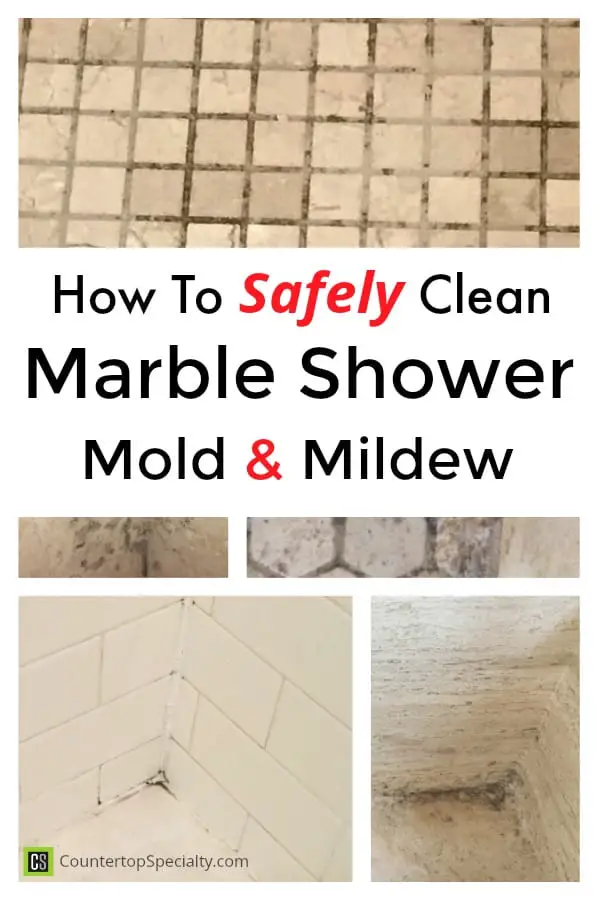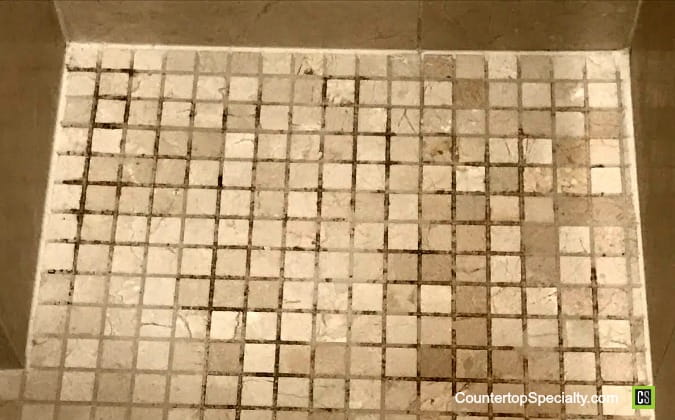Cleaning Marble Tile Shower Mildew
QUESTION
I have a marble tile shower with a big mold and mildew problem. The flooring of the stall is tumbled marble and is dull in color. The walls are polished marble and are shiny.How do I clean this marble shower so I can kill the mold and mildew and once killed, keep it at bay?

ANSWER:
Marble shower mold & mildew is essentially due to the presence of excess or constant moisture. Excess moisture can exist for several reasons or a combination of problems.The cleaning part is easy...
This Bath & Shower Kit for Marble has everything you need for mold and mildew removal and cleaning marble showers in general.
The Mold & Mildew Remover is used, naturally, for cleaning shower mold and mildew.
Then for regular weekly shower cleaning use the Soap Film Remover. Soap scum is the major cleaning issue for showers which can lead to mold growth so good to use these in tandem.
These product are specially formulated to be effective and non-damaging on marble (polished and tumbled) travertine tile, granite tile and all stone for that matter.
Using the correct cleaners for specific problems will help you avoid damaging your marble countertops and tile.
But just cleaning off the mold & mildew may not completely solve the problem...
Eliminating the cause of persistent moisture (leading to mold) is the tricky part.
Recurring shower mildew results when the shower is not drying out due to:
- Poor bathroom ventilation
- Cracks in grout and caulk
- Water getting behind the tiles
- Plumbing leak
To prevent mold and mildew growth in the shower:
- Inspect and fix all cracks in grout / caulk
- Fix plumbing leaks and drips
- Use a squeegee to wipe water from shower walls
- Leave shower door/curtain open after use
- Leave exhaust fan on until dry
- Open window blinds to allow sunlight in
- Clean shower more frequently (1x/week min)
Sunlight helps to kill/prevent mildew growth in case you're wondering "why" for that particular suggestion.

To detect and fix grout cracks and plumbing leaks:
- First, quit using the shower for 4 or 5 days to allow it to dry out completely.
- Check for moisture. If any water or wetness is noted after 5 days, then likely you have a plumbing leak and/or a problem with the shower pan beneath the marble floor tile. Both issues will require professional help.
- Repair all drips and plumbing problems.
- Then inspect all grout lines and caulk paying particular attention to the junction between the wall and floor and in the corners. These are common spots for deterioration.
- Re-grout and/or caulk areas with cracks and voids.
Follow the steps to prevent mold & mildew outlined above, but use the suggested product at the first sign of new spot.
If after thorough cleaning of existing mildew you still see signs of mildew, it is likely a stain in the grout, caulk or stone. In other words, the mildew has absorbed and/or is growing beneath the surface where it is difficult/impossible for any cleaner or "cleaning" method to be effective.
This
If in the caulk, remove and replace. To remove a mildew stain from the grout or stone follow instructions in the Removing Granite & Marble Stains e-book.
Sealing Showers Does Not Prevent Mildew
Sealing a marble shower or a travertine shower is generally unnecessary (except white marble) and it won't prevent growth of mold or mildew.
First, sealing only helps prevent staining of the stone and true stains in showers are rare. Mold & mildew are not stains. Most bath products won't stain unless left on the surface a long time and that doesn't occur much in a shower with all the water washing things down the drain.
Stains in stone are rarely permanent and easy to remove in nearly all cases. Makes sense to seal a bathroom or kitchen countertop, floor tile, etc... just not a shower.
Long-term presence of shower mildew could stain marble, but much better to prevent the mold from developing.
Second, it is best to leave stone alone in a wet environment. With so much water, if it does get behind the stone tile, the sealer will then trap the moisture leading to degradation of the stone.
Not to mention that both marble and travertine are dense and very stain-resistant especially when polished. The idea that "marble stains easy" is totally bunk. It "etches" easy... completely different matter.
And you don't apply a sealer to prevent water absorption into the stone. This does not cause any problems because with marble/travertine very little water (if any) will absorb. The little that does evaporates quickly (with proper ventilation, etc.)... no problem, no mildew.
Also, mildew grows on top of the surface, so even if you did prevent water absorbing into the stone you may still get mold and mildew due to the above stated reasons for excess or persistent moisture.
Usually applying a sealer in a shower won't "cause" any problems, but it doesn't provide much benefit either, so just wasted money and effort.
For more on sealing and stains see the marble stains page.
Proper tile installation, keeping the grout in good shape, ventilation, regular cleaning, and following marble cleaning do's & don'ts are the key factors to maintaining the integrity of a marble tile shower.
A word about the "dull" tumbled marble tile.... Yes, tumbled marble tile has a more muted color than polished and so "cleaning" is not going to change that. The tumbled marble is used for better footing.
I gather you understand this, but just wanted to clarify, that the difference in color and finish is not directly related to cleaning or sealing.
However, you could have a build up of soap scum that makes it all look a bit dull and dirty.
For removing soap scum use this Soap Scum / Hard Water Remover.
A soap film could also help foster growth of mildew, so beneficial to remove it.
Hopefully this helps you solve the mold and mildew removal issue once and for all. Follow the suggestions above and you shouldn't have future problems effectively cleaning your marble tile shower.
Comments for Cleaning Marble Tile Shower Mildew
|
||
|
||


